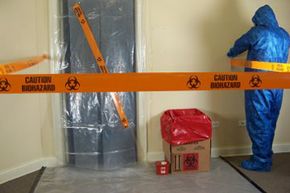The Basics
CTS decon is a niche market within the cleaning industry, and it involves cleaning up dangerous material. This could mean the biologically contaminated scene of a violent death (homicide, suicide or accidental), the chemically contaminated scene of a methamphetamine lab, or an anthrax exposure site [source: Sahadi]. Crime-scene cleaners come in and restore the scene to its pre-incident state, known in the business as remediation.
When a violent death occurs in someone's home, the family typically doesn't move out [source: Darr]. The cleaners' job is to remove any sign of what happened and any biohazards that resulted from it. Federal regulations deem all bodily fluids to be biohazards, so any blood or tissue at a crime scene is considered a potential source of infection. You need special knowledge to safely handle biohazardous material and to know what to look for at the scene – for instance, if there's a thumbnail-size bloodstain on the carpet, there's a good chance that there's a 2-foot-diameter bloodstain on the floorboards underneath it. You can't just clean the carpet and call it a day. You also need permits to transport and dispose of biohazardous waste. CTS decon specialists have all of the necessary permits, training and, perhaps most important, willingness to handle material that would send most of us running out the door to throw up in the bushes. A lot of them come from medical fields that prepare them for the gore -- they may have been EMTs or emergency room nurses. A construction background is helpful, too, because some clean-ups (especially meth labs) require walls and built-in structures to be removed.
Advertisement
Crime-scene cleaners handle a wide variety of messy situations – violent deaths, animal-hoarding sites, meth labs, even tear-gas clean-up – each of which carries its own particular dangers and unpleasantries. They are "secondary responders," arriving after the police, paramedics and coroner have left. The scene is typically already secured, ready for the crew to start their work.
